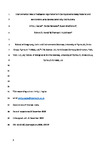Environmental risks to freshwater organisms from the mycotoxins deoxynivalenol and zearalenone using Species Sensitivity Distributions
| dc.contributor.author | Eagles, Emily | |
| dc.contributor.author | Benstead, R | |
| dc.contributor.author | MacDonald, S | |
| dc.contributor.author | Handy, Richard | |
| dc.contributor.author | Hutchinson, Tom | |
| dc.date.accessioned | 2021-03-25T15:05:14Z | |
| dc.date.issued | 2021-03 | |
| dc.identifier.issn | 0045-6535 | |
| dc.identifier.issn | 1879-1298 | |
| dc.identifier.other | 129279 | |
| dc.identifier.uri | http://hdl.handle.net/10026.1/16981 | |
| dc.description.abstract |
In this study, laboratory experiments have addressed the acute toxicity of two common mycotoxins, deoxynivalenol (DON) and zearalenone (ZON), in a range of freshwater organisms (including rotifers Brachionus calyciflorus, insects Chironomus riparius (larvae), crustaceans Daphnia pulex and Thamnocephalus platyurus, cnidarians Hydra vulgaris, molluscs Lymnaea stagnalis (embryos) and Protozoa Tetrahymena thermophila). Acute EC50 values highlight crustaceans as the most sensitive organisms to DON, with T. platyurus having a 24 h EC50 of 0.14 and D. magna having a 48 h EC50 of 0.13 mg DON/L. During exposures to ZON, H. vulgaris and L. stagnalis embryos showed the highest sensitivity; mortality EC50 values were 1.1 (96 h) and 0.42 mg ZON/L (7 d), respectively. Combining these novel invertebrate toxicity results, along with recent published data for freshwater plant and fish toxicity for analysis of Species Sensitivity Distributions, provides freshwater HC5 values of 5.2 μg DON/L and 43 μg ZON/L, respectively. Using highest reported environmental concentrations and following REACH guidelines, risk ratios calculated here show the risk of ZON to freshwater organisms is low. In contrast, DON may periodically because for concern in streams subject to high agricultural run-off, likely during certain times of year where cereal crops are susceptible to higher fungal infections rates and may pose increased risks due to climate change. | |
| dc.format.extent | 0-0 | |
| dc.format.medium | Print-Electronic | |
| dc.language | en | |
| dc.language.iso | en | |
| dc.publisher | Elsevier BV | |
| dc.subject | Emerging chemical | |
| dc.subject | Ecological risk | |
| dc.subject | Hazard assessment | |
| dc.subject | Lethal toxicity | |
| dc.title | Environmental risks to freshwater organisms from the mycotoxins deoxynivalenol and zearalenone using Species Sensitivity Distributions | |
| dc.type | journal-article | |
| dc.type | Journal Article | |
| plymouth.author-url | https://www.webofscience.com/api/gateway?GWVersion=2&SrcApp=PARTNER_APP&SrcAuth=LinksAMR&KeyUT=WOS:000608802100114&DestLinkType=FullRecord&DestApp=ALL_WOS&UsrCustomerID=11bb513d99f797142bcfeffcc58ea008 | |
| plymouth.volume | 267 | |
| plymouth.publication-status | Published | |
| plymouth.journal | Chemosphere | |
| dc.identifier.doi | 10.1016/j.chemosphere.2020.129279 | |
| plymouth.organisational-group | /Plymouth | |
| plymouth.organisational-group | /Plymouth/Faculty of Science and Engineering | |
| plymouth.organisational-group | /Plymouth/Faculty of Science and Engineering/School of Biological and Marine Sciences | |
| plymouth.organisational-group | /Plymouth/REF 2021 Researchers by UoA | |
| plymouth.organisational-group | /Plymouth/REF 2021 Researchers by UoA/UoA06 Agriculture, Veterinary and Food Science | |
| plymouth.organisational-group | /Plymouth/Research Groups | |
| plymouth.organisational-group | /Plymouth/Research Groups/BEACh | |
| plymouth.organisational-group | /Plymouth/Research Groups/Marine Institute | |
| plymouth.organisational-group | /Plymouth/Users by role | |
| plymouth.organisational-group | /Plymouth/Users by role/Academics | |
| dc.publisher.place | England | |
| dcterms.dateAccepted | 2020-12-08 | |
| dc.rights.embargodate | 2022-12-11 | |
| dc.identifier.eissn | 1879-1298 | |
| dc.rights.embargoperiod | Not known | |
| rioxxterms.versionofrecord | 10.1016/j.chemosphere.2020.129279 | |
| rioxxterms.licenseref.uri | http://www.rioxx.net/licenses/all-rights-reserved | |
| rioxxterms.licenseref.startdate | 2021-03 | |
| rioxxterms.type | Journal Article/Review |


